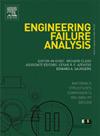高速列车冲击下铁路桥梁钢筋混凝土防护墙抗碰撞性能评价
IF 5.7
2区 工程技术
Q1 ENGINEERING, MECHANICAL
引用次数: 0
摘要
随着铁路桥网络的扩展,列车运营暴露于高架环境的风险越来越大;在这种情况下,任何脱轨都会带来更高的后果严重性,强调了预测脱轨后碰撞动力学的必要性。以我国典型的双轨无砟铁路桥梁体系为研究对象,建立了高速列车与钢筋混凝土防护墙的多尺度动态碰撞模型。该模型采用质量-弹簧-阻尼器系统来表示车辆的非冲击动力学,并采用了将纤维梁和三维实体单元集成在一起的分区混合方法,从而实现了精确的RCPW损伤模拟,同时将计算时间减少了约70%。在此基础上,提出了一种新的转向架运动平面法,通过计算空间角度和位移时程,分析了列车从轮轨接触失效到碰撞的动力学行为。采用增广均匀设计抽样方法,结合高斯过程代理模型和Sobol灵敏度分析,建立了列车- rcpw耦合效应的评价方法。主要研究结果表明:(1)列车横向速度(vx)控制着碰撞模式——vx≤2.5 km/h会导致与底板的初始碰撞,然后与RCPW发生二次碰撞,而vx≥7.7 km/h会导致与RCPW的直接碰撞;(2)优化纵向钢筋屈服强度比提高混凝土抗压强度更有效。本文章由计算机程序翻译,如有差异,请以英文原文为准。
Evaluation of the anti-collision performance of reinforced concrete protective wall for railway bridges under high-speed train impact
With the expansion of railway bridge networks, the exposure of train operations to elevated environments has grown; in such settings, any derailment carries higher consequence severity, underscoring the need to predict post-derailment collision dynamics. This study focuses on a typical Chinese dual-track ballastless railway bridge system and develops a multi-scale dynamic collision model for high-speed trains and reinforced concrete protective wall (RCPW). The model employs a mass-spring-damper system to represent the vehicle’s non-impact dynamics and applies a zoned hybrid approach that integrates fiber-beam and three-dimensional solid elements, thereby enabling accurate RCPW damage simulation while reducing computational time by approximately 70 %. Furthermore, a novel bogie motion plane method is introduced, which analyzes the train’s dynamic behavior from wheel-track board contact failure to collision by computing spatial angles and displacement time histories. An augmented uniform design sampling approach, combined with a Gaussian process surrogate model and Sobol sensitivity analysis, is employed to establish for evaluate the train-RCPW coupling effect. Key findings reveal that (1) lateral train speed (vx) governs collision patterns—vx ≤ 2.5 km/h results in an initial collision with the base slab followed by a secondary collision with the RCPW, while vx ≥ 7.7 km/h leads to a direct collision with the RCPW—and (2) optimizing the yield strength of longitudinal reinforcement is more effective for energy dissipation than increasing concrete compressive strength.
求助全文
通过发布文献求助,成功后即可免费获取论文全文。
去求助
来源期刊

Engineering Failure Analysis
工程技术-材料科学:表征与测试
CiteScore
7.70
自引率
20.00%
发文量
956
审稿时长
47 days
期刊介绍:
Engineering Failure Analysis publishes research papers describing the analysis of engineering failures and related studies.
Papers relating to the structure, properties and behaviour of engineering materials are encouraged, particularly those which also involve the detailed application of materials parameters to problems in engineering structures, components and design. In addition to the area of materials engineering, the interacting fields of mechanical, manufacturing, aeronautical, civil, chemical, corrosion and design engineering are considered relevant. Activity should be directed at analysing engineering failures and carrying out research to help reduce the incidences of failures and to extend the operating horizons of engineering materials.
Emphasis is placed on the mechanical properties of materials and their behaviour when influenced by structure, process and environment. Metallic, polymeric, ceramic and natural materials are all included and the application of these materials to real engineering situations should be emphasised. The use of a case-study based approach is also encouraged.
Engineering Failure Analysis provides essential reference material and critical feedback into the design process thereby contributing to the prevention of engineering failures in the future. All submissions will be subject to peer review from leading experts in the field.
 求助内容:
求助内容: 应助结果提醒方式:
应助结果提醒方式:


